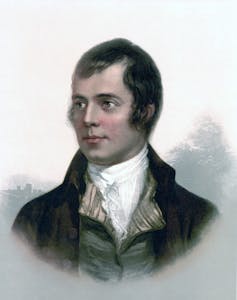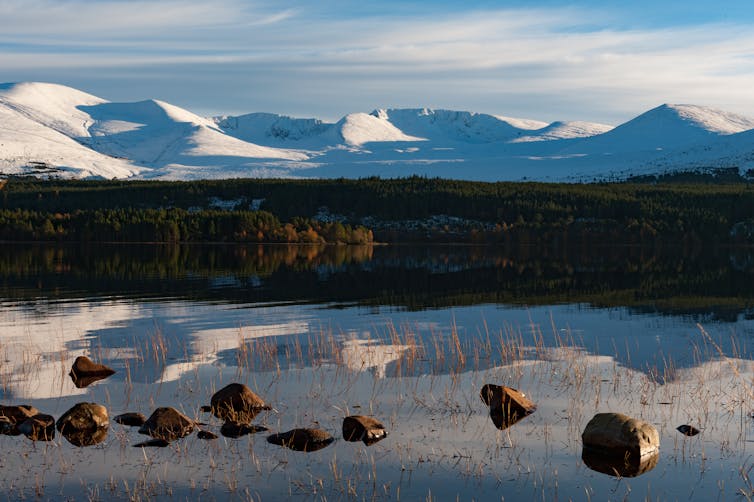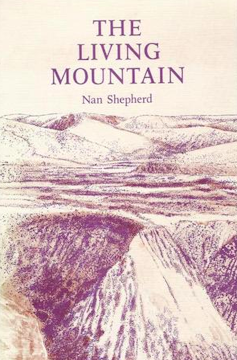The half-light of these weary January days will soon be lit up by the linguistic thrills of Burns Night. This international celebration of Robert Burns’ timeless poetry will see millions across the world raise a glass to Scotland’s bard on January 25.
Burns is used by Scots as a frame upon which to hang a tremendous amount of weighty national identity. Upon him they place responsibility as the source of their egalitarian spirit, and of their radicalism. Their socialist leanings too, they expect him to inhabit. Their fondness for a good drink is perhaps the easiest burden for his writing to bear.
As Scotland develops and alters, more and more weight is being borne by this one Ayrshire man. Even his ghost must be growing humpbacked under the strain. Academics and fanatics scratch annually through his letters and works, trying to pin him down as a good unionist, socialist, yes man, Tory. Others look to take him out by labelling him a sexual predator or aspirant slave-owner. This Burnsian battleground shows that Scottish identity can no longer be encompassed in one night nor expressed by one man.

Scotland needs a new symbol that can more easily take on the country’s emergent identities. Environmentalism is a huge new concern, as is a real effort to achieve equal status for women. Perhaps the most current debate is the attempt to redefine Scots’ relationship with the Highlands. These aggressively depopulated regions have inhabited an uncomfortable place in the Scottish psyche, with a romantic, tourist-friendly notion of leaping salmon and noble stags competing with the tragedy of the Clearances, when greedy landlords swept crofters from their land in the 18th and 19th centuries in favour of more profitable sheep.
A woman for the job
By an incredible stroke of luck, we have just such a poetic hero hung up in a cupboard, ready to be pressed into action: the accomplished Aberdonian novelist and poet, Nan Shepherd, who played a vital role in the 20th-century Scottish Renaissance.
Born in Peterculter and raised in Cults, her existence was forever focused on Aberdeen, as seen through her degree at the city’s university and her long career teaching at the college, and her love for the Cairngorm Mountains just inland to the west. From her firm footing in the north-east, she was able to step confidently out into the world both through travel and through addressing universal human questions from a confidently north-east perspective.
Shepherd has already been dusted off and given a relaunch recently. In 2016, the Royal Bank of Scotland used a striking image of the poet wearing a self-made headband, looking proud and confident on its new five-pound note. In 2017, a well-received biography, Into The Mountain, was published, digging down into the life of the woman behind the books.
This foundation has prepared the way for a wide popular embrace. But Scots don’t take someone to their hearts because some well-meaning soul has put out a biography. Nor do they warm to someone purely because they decorate the fivers that glide effortlessly through their fingers.
That’s why alongside Burns, I propose Nan Shepherd Night.
This night would be roughly analogous to Burns’ annual birthday bash in that there would be much discussion of themes and politics and social consequence, well lubricated and studded with readings and song.
A force of nature
Raising Shepherd up to this new prominence would give every new generation the chance to interact with one of the most compelling Scots voices of the 20th century. Her work in both Scots and English produced principally in the 1930s spoke to and of a nation in transition. She also wrote of nature in a way that would be intensely valuable for us all to read. In her poem The Hill Burns, she writes:
Wet with the cold fury of blinding cloud,
Through which the snow-fields loom up, like ghosts from a world of eternal annihilation,
And far below, where the dark waters of Etchachan are wont to glint,
An unfathomable void.
Out of these mountains,
Out of the defiant torment of Plutonic rock,
Out of fire, terror, blackness and upheaval,
Leap the clear burns,
Living water,
Like some pure essence of being,
Invisible in itself,
Seen only by its movement.
Her 12-part essay on time spent walking in the Cairngorms, The Living Mountain, has been in the spotlight once again since its timely re-release in 2011 by Canongate Books, with a foreword by academic and nature writer Robert MacFarlane. This slow, revelatory examination of a human immersed in nature is a very powerful piece of writing.

The slim volume could be easily dispatched in a single sitting, but like one of the walks that ramble from page to page, glen to glen, it can be revisited time and again, with new revelations being provoked, new vistas glimpsed on each fresh journey. As mentioned, Shepherd breaks us, and Scottish literature generally, out of the old dichotomy where the Scottish landscape could only be viewed in one of two ways.
Either Scotland was a misty, ancient place of few people and many romantic notions, or it was a bleakly bare northern extremity from which humans had first scoured clean of the trees then scoured clean of their own ramshackle dwellings and cultures.
Shepherd offers us a third way, a way of approaching the landscape that allows a natural and unmediated relationship to be created between human and landscape, between the two living things.
Taking her rightful place
Raising Shepherd up to the height of national figure would at long last put a woman among the pantheon of Scottish greats. Burns, Scott, Stevenson, Grassic Gibbon, Gunn: they all have their place, but they are all men and can only inspire so many of us, and only in so many directions.
A strong, confident female voice being celebrated, read and enjoyed at events around the country with predominantly female speakers would be a welcome antidote to the heavily masculine Burns Night with its conspicuous array of male worthies. Balancing this out would be to the enrichment of both men and women.
Finally, raising Shepherd’s status would undoubtedly also bring the north-east back into focus as one of the cultural heartlands of Scotland. The deep-rooted culture of Scotland’s geographical cold shoulder has often been neglected by those in the central belt. But while Edinburgh softened itself through Anglicisation, Aberdeen retained its sense of self.

In the north-east, there is a special mentality of hard-headedness and a dark passion for enduring hardship with stoicism – locals proudly call it being “thrawn”. There is the linguistic richness of the local Scots dialect that extends across all classes. There are the rich traditions of fiddle music, ballads and bothy ballads, folktales and legends, high literature and street literature, that inform an ongoing strength of identity and creativity here. Nan Shepherd’s work beautifully illustrates this, and for Scotland’s identity builders in the central belt, a better understanding of Shepherd’s work could act as a bridge to the rich kist of tradition and culture in the north-east.
Shepherd skilfully brings the reader to points of transition and contrast – between hills and sky, modernity and tradition, Scots and English, male and female – walking us through the revelatory landscape, examining it, learning from it. By looking at issues such as class, gender, nature and what it means to be fully alive, Shepherd’s illuminating works equip us to deal with change. In the current climate, that’s not a bad skill to have.
Nan Shepherd was a vital player in the Scots Renaissance of the 20th century, and helped secure Scots’ place as a literary language. As a great makar (poet) in her own right, who used Scots regularly in her work, she also acted as a vital motivator and organiser of others in the movement. Now we are in the midst of another Scots renaissance, and during Scots Language Week, it is only fitting that an article championing Shepherd should be written in Scots as well as English.
Shift yersel owre, Rabbie, an mak space fir a national lassie
Burns Nicht is here aince mair. Aa owre this guid green warld, Scots an their sympathisers will pit oan their best tartan breeks, kilts, sashes an bunnets, an heid for a local dinner.
Ae dey a year we aa breenge oot fae oor hidden neuks, oor mooths aflame wi Burns’ Scots an oor bellies aflame wi strang hielan uisge-beatha. We haver on aboot the values o freedom an equality, resistance tae tyranny, an aa that Scotland stauns fir in this tapsalteerie warld.
Then the next-again dey sees us hingin up aa wir tartan duds, pittin wir Scots tongues back intae the press alang wi oor dirks an kilt soaks. Scotland an aa her Burns-inherited notions safely back in the box unner the bed fir anither year.
Burns is cairtin owre muckle a load fir ae single Ayrshire mannie. An a hail nation sae complex an modren as Scotland needs mair nor ae champion.
Scotland could dae wi a new poetic hero wha could gie voice tae oor new environmentalist impulse, tae the ambition thats mair common nor ever in Scotland tae heize up women tae truly equal status wi men, an tae appreciate the abundant beauties an discovery open tae us in oor hauf-toom glens.
A quine for the task
We already hae sic a hero. She’s caaed Nan Shepherd. Nan (Anna) Shepherd wis a gey important pairt o the Scottish Reneaissance o the twentieth century. She wis a braw scriever in her ain richt, plus organiser an communicator an kyther o ideas an concepts. She wis an Aiberdeenshire quine, born intae a faimly fae Peterculter an raised at Cults, she wis aye at hame in the north-east, fae her deys studyin intae Aiberdeen University tae her lang career teachin English at the Aiberdeen College.
She’s aaready been singled-oot fir a bit o a re-launch. Her face appears on the fivers fae the Royal Bank o Scotland, an a new biography o her is oot tae. Unlike Burns, Shepherd redded oot maist o the dodgy stuff fae her diaries, editied her ain letters an even pit a wheen o documents tae the fire afore she deid. Unlike big Rabbie, then, we dinnae hae aa the interestin, incriminatin opinions o the figure tae chaw through an reinterpret. We’re left wi her wark. But thon’s plenty.
Sae this braw brankie new symbol o Scottish identity needs a new National Nicht. Oor ain ane, no tae replace Burns but tae compliment him. A Nicht that shaws the warld whit we are aa aboot these deys an wad gie us leave tae stert oor ain traditions.
That’s how I propone Nan Shepherd Nicht.
Airt fae the earth
Explorin Shepherd wad be worthwhile as wad gie ilk new generation a chaunce tae read ane o the best, maist compellin an unique voices o the 20th century. She scrievit poems in baith Scots and English, novels that encompassed life in her north-east hame an celebrated the people, nature an leids that sae define the place, whilst aye haein ae ee on the bigger picture o humanity.
Exploring Shepherd wad gie us a chance tae meditate on oor relationship wi nature. Her maist celebratit wark the dey is The Living Mountain. The non-fiction twal-pairt essay chairts Shepherd’s slaw, revelatory experiences o merchin through the Cairngorms.
This slim buik isnae a chyave tae get through in ae sittin, yet like ane o the rambles Nan taks hersel on, ilk time ye pick it up an hae a read, ye tak new thochts awa, hae new ideas. Shepherd’s unco relationship wi nature braks oot o the auld dichotomy o Scottish literatur. Afore her, the Scots launscape was either a romantic harr-happit laun o bonnie stags an loupin saumon or a harsh, wind-bit wastelaun whaur oor ancestors aince scarted oot a livin afore bein torn fae their hames bi greedy lairds an cruel factors. Shepherd gies us a third wey, whaur ilk human can hae honest communication wi nature an form their ain relations, ootwith aa the fauseness o prejudiced interpretation.
The Shepherd alangside the Plouman Poet
Explorin Shepherd wad at lang last pit a female in the pantheon o Scottish greats. Burns, Scott, Stevenson, Grassic Gibbon, Gunn: they aa dae a job fir oor national identity. But they aa dae it fir ae gender. Burns Nichts are gey aften heavy on the male spikkers. Haein a Shepherd Nicht whaur maist spikkers were female wad balance this oot.
Finally, explorin Shepherd wad bring the north-east back intae the fauld o “national” Scotland. This airt has lang been the kist that stores some of Scotland’s richest treisures in terms o cultur, leid, an nature. The hail nation o Scotland could turn, through the wark o Shepherd, tae the north-east an fae its deep kist draw forth wirds hauf-forgot in the sooth, an mentalities that were tint lang-syne.
Sheperd aye brings us tae a transition; atween the taps o hills an the high blue lift, atween modernity an tradition, Scots an English, male an female, an she walks wi us roon it, examinin it, learnin fae it. She equips us tae deal wi change, an in the current dey, thats nae a bad skill tae hae.

